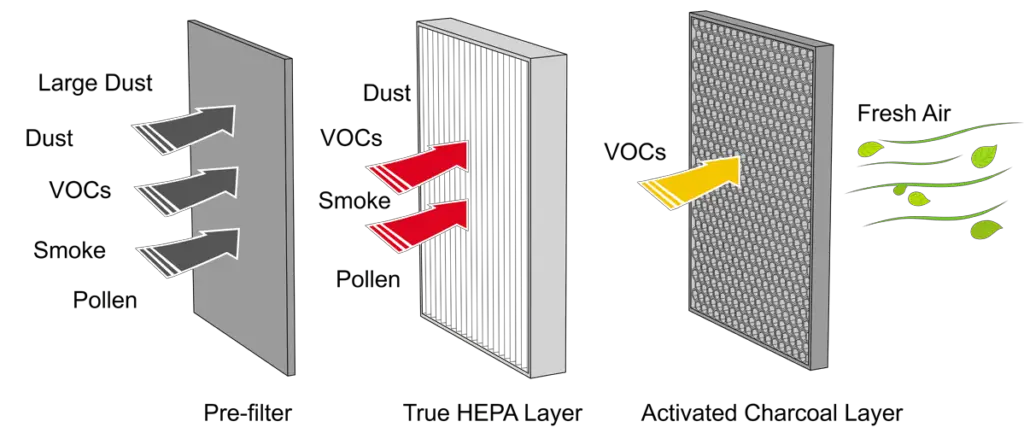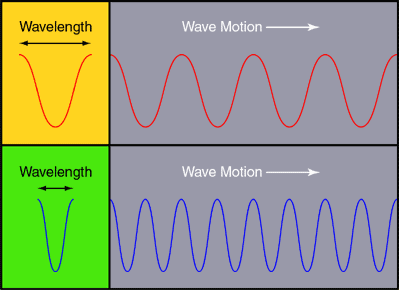HEPA filters and UV light are two common methods of air purifying. While both of them have the same goal of improving your indoor air quality, the technology behind this is quite different. In addition to that, not all purifiers clean the same type of air pollutants – same goes for HEPA filters and UV light. There are many different types of air pollutants in the air that you breathe, so choosing the correct air purifier type makes a big difference. That being said, what is the difference between HEPA filters vs UV light?
In short, HEPA filters vs UV light differ by the air cleaning method and type of air pollutants they can remove. HEPA filters clean the air with the use of filters, which are located inside the air purifier. As polluted air passes through the device, HEPA filters capture many of these harmful pollutants and keep them trapped inside. On the other hand, UV light air purifiers use certain ultraviolet wavelengths to literally destroy airborne pathogens and pollutants, but are ineffective against other air pollutant types. HEPA filters are effective are removing up to 99,97% of all air pollutants as small as 0.3 microns. UV light is specifically designed to remove bacteria & viruses, and is also a great disinfectant.
Both of these devices ultimately share a common goal – clean indoor air. Next, we are going to take a closer look into both of these air purifying methods and describe the difference of HEPA filters vs UV light more in detail.
Air cleaning method of HEPA filters vs UV light
I have already mentioned in the intro that one of the two main differences between HEPA filters and UV lights is the way they clean air. Now let us get into a bit more detail.
The first “actual” HEPA filters have been appearing since the mid-70s and continue to have a strong foothold in the air purifying world even today. The concept is quite simple really – HEPA filters are basically mats made of glass fibers that capture both large and small particles – as small as 0.3 microns in diameter. Here is a visual presentation of a filtration system that uses HEPA filters as their main source of air cleaning.

Source: Prana air
HEPA filters are located inside of the air purifier housing. Fans suck the air inside of the device, and push it through different filters, with HEPA being the main cleaning filter. As the air passes through them, these different types of filters capture pollutants and other harmful particles, separating them from the air. After the filtration stage is complete, a set of fans (or one fan) push the newly cleaned air back into the room. A typical air purifying system like this consists of a pre-filter, HEPA filter and Carbon activated filter. I will touch more on this in the next section, in combination with different air pollutant types.
On the other hand, UV light air purifiers use an ultraviolet lightbulb to emit ultraviolet light which removes certain air pollutants. To understand this, we first need to define a very special word – photon. Photons are tiny particles that make up what we call “light”. As photons move around, they vibrate, creating a wave of space. The quicker these photons vibrate, the shorter the distance will be between these waves; and vice-versa. The shorter this distance is (meaning the faster photons vibrate), the more energy is created.

Light comes in different wavelength ranges, which we measure in nanometers (nm) Our human eyes can detect wavelengths between 400-700 nanometers. We can not detect UV light, which has a wavelength below 400 nanometers (nm). UV light can be broken down into 3 smaller groups: UV-A light, UV-B light, and UV-C light. The difference between them is the wavelength range: UV-A light has a 315-400 nm range, UV-B between 280-315 nm, and UV-C between 100–280 nm. UV-C light is the fastest and carries the most energy between the three.
Which air pollutants do they remove?
The next big difference between HEPA filters vs UV light air purifier is which harmful air particles they are effective against.
In the previous section, I have already mentioned that HEPA filters are very effective at removing air pollutants as small as 0.3 microns. Since 0.3 microns does not really tell a whole lot, I have prepared a graph that shows you the size difference of the most common air pollutants. This will make it easier to get a somewhat better grasp on the relative scale and size of these harmful air particles.
Common Indoor Pollutant | Particles Size in Microns |
Pollen, mold and plant spores | 7-70 |
Dust mites | 3-10 |
Hairspray | 3-10 |
Large bacteria | 1-20 |
Lead dust | 1-3 |
Auto emissions | 1-3 |
Fungal spores | 0.5-7 |
Cooking odors | 0.3-1 |
Dust | 0.2-8 |
Pet dander | 0.15-8 |
Small bacteria | 0.08-1 |
Tobacco smoke | 0.008-0.6 |
Viruses | 0.005-0.001 |
VOC (volatile organic compounds) | Less than 0.001 |
As you can see, HEPA filters are effective at removing most of the above listed harmful air pollutants from the air. What HEPA filters are not very effective at removing are viruses, bacteria, fumes, VOCs (volatile organic compounds), odors…basically particles that are smaller than 0.3 microns.
What is also important to mention here is that there are different tiers of HEPA filters, which are marked with E/H/U+ number. The higher the number = the higher the tier = better air cleaning capabilities. I am not going to spend too much time on this particular subtopic, but H13 and H14 HEPA filters belong in the top tier, for commercial use. Below you can find a table of different HEPA filter tiers and their effectiveness for removing air pollutants of 0.3 microns and up.

On the other hand, UV light air purifiers specialize in destroying airborne pathogens, such as viruses and bacteria. You could say that UV light is basically a great disinfectant tool. Pretty much all UV air purifiers that I have come across use UV-C light which has the fastest wavelength. While UV-A and UV-B wavelength can also destroy airborne pathogens, scientific research shows that UV-C light is the most effective, as it downright changes the genetic material of pathogens such as viruses and bacteria. Outside of this specific use, UV light air purifiers are not effective against other types of indoor air pollutants.
Comparison of pros and cons
No air purifier is perfect and without flaws. Similarly, both HEPA filters and UV-C light air purifiers come with their own set of benefits and disadvantages. To consolidate this information, I have prepared a pros & cons comparison table between the two, for a quick summary.
Source: ionizerhub.com
As you can see from the table above, HEPA filters are a very effective and generally durable air cleaning solution. It is no wonder that they are the most popular type of air purifiers. Cheap to make, but at the same time an excellent air cleaning ability – a strong combination to have. The biggest downside is that they can not remove all types of air pollutants – particles that are smaller than 0.3 micrometers in size. These can not be effectively stopped by HEPA filters and mostly just pass through it. HEPA filters also lose effectiveness over time. Depending on the HEPA filter quality and tier, so you can expect to change some of them as often as every 3 months. I would say that many need to be replaced twice a year, while the better quality ones need replacement only once a year (a few even last 2-3 years!). If you do not replace them, then the air cleaning effectiveness goes down. Not only that – unclean filters can become a hotspot for viruses and bacteria.
Source: ionizerhub.com
UV-C air purifiers have a very niche or specific use – as a means to remove harmful pathogens from the air. They actually destroy viruses & bacteria, and not just capture them. This makes them a great disinfectant and germicide tool. UV lightbulbs are also usually very durable and can last you a couple of years (up to around 5 years). Harmful pathogens are the only air particle type that UV-C light air purifiers can remove – they are not effective at removing other air pollutants, which limits their overall usefulness. Another big downside is that most UV-C wavelengths produce ozone, which is harmful to your lungs (even in small amounts). You can read more about the negative aspects of ozone in my other post here.
Which one should I use?
If you have made it this far, then one of the big remaining questions in HEPA filters vs UV light debate is which one is right for you? In the vast majority of cases, I would argue that air purifiers which use HEPA filters are a much better choice over UV light purifiers. First, you have to consider the overall difference in effectiveness. While HEPA filters are somewhat limited by particle size, they are not really as limited as UV-light purifiers. Also, keep in mind that quite a few HEPA filtration systems combine other air purifying methods, UV-C light included, to provide a more complete air filtration process.
Building on the previous sentence, UV-C light purifiers can come as a standalone unit, or as a part of a bigger filtration system. Standalone UV-C light units are often very costly due to the relatively new technologies in this field, so a combined unit (UV-C light as part of a bigger filtration system) is better in pretty much every case, especially for commercial use.
I see only one situation where I would take a UV light air purifier over HEPA filters – if you have a specific virus or bacteria issue that you would like to get rid of. And even then, you could get away with taking a HEPA filtration system, that has an added UV-C lightbulb as a feature. For all other cases, such as allergies, general air cleaning, odor issues, respiratory problems…HEPA filters are the better choice.
If you are new to air purifiers and are thinking about trying one out – I have prepared a list of the top 5 best budget-friendly air purifiers under $50. All of them use HEPA filters, but I have also included one that has a combination of HEPA filter and a UV-C lightbulb; so you can get the best of both worlds. It is a very detailed post, so feel free to check it out. In any case, I hope you enjoyed this post and learned something new today!